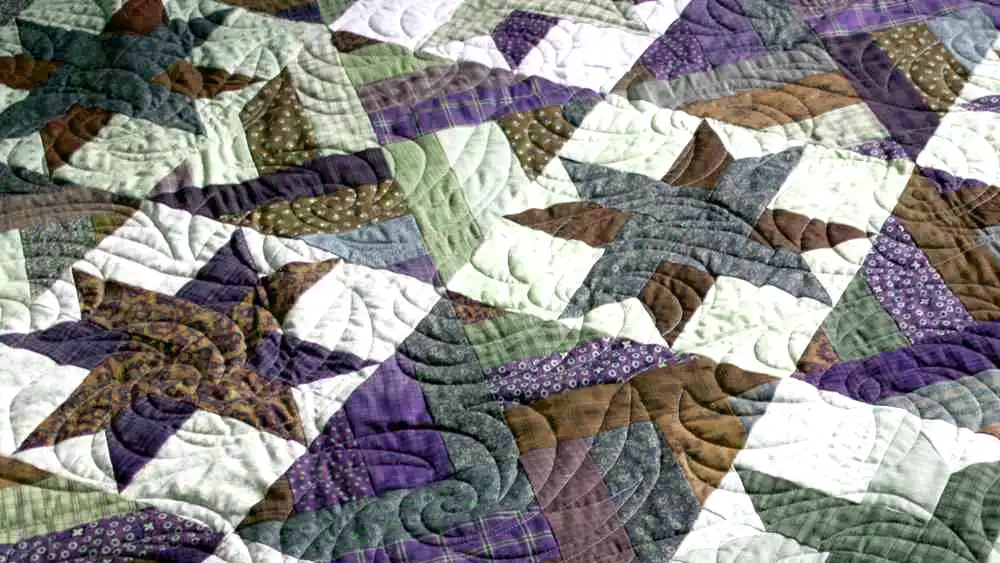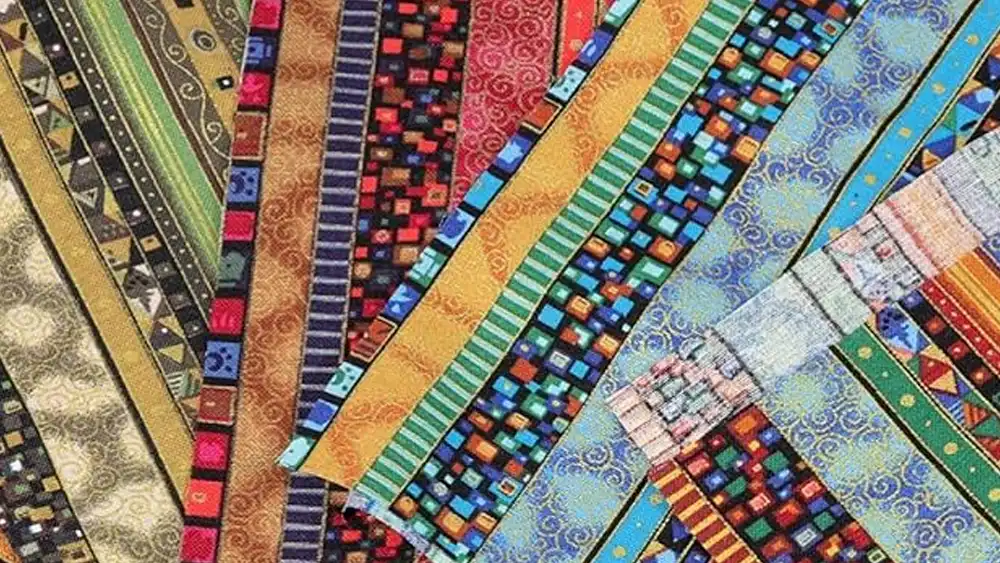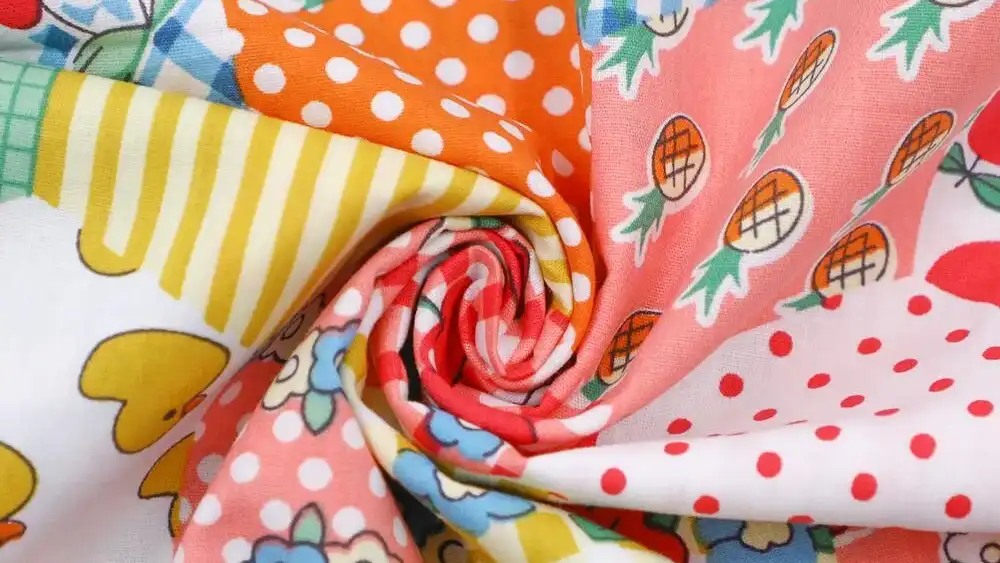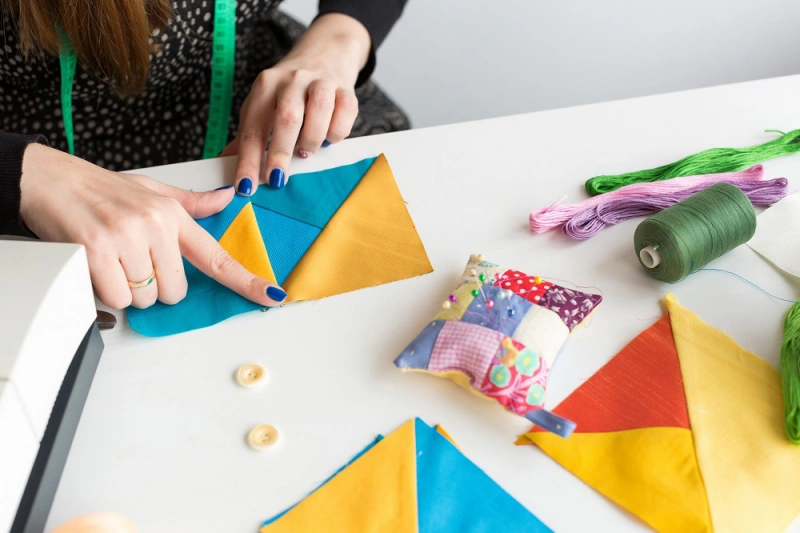If you’re new to quilting, you might wonder, “What is patchwork fabric?” In simple terms, it’s fabric made by sewing small pieces together to form a larger design, often used for quilts. Patchwork fabrics come in many colors, patterns, and styles, giving you endless creative possibilities.
Whether you’re making a quilt or other crafty projects, understanding patchwork is key. Ready to dive in? Learn more about What Is Patchwork Fabric and start your quilting journey!
What Is Patchwork Fabric?

Patchwork refers to a textile art form in which small pieces of fabric are stitched together to form a larger design. These pieces of fabric, known as patches or quilt blocks, are often cut into geometric shapes such as squares, triangles or hexagons.
They are then arranged in a visually pleasing pattern. Patches can be made from a variety of fabrics, including cotton, silk, wool and linen, and can be in different colours, prints and textures.
What Is Patchwork Fabric History?
It began in ancient times when small fabric scraps were sewn together to create practical quilts and clothing. As trade routes expanded, patchwork techniques spread, with each culture adding its own unique patterns.
The Industrial Revolution made fabric more accessible, helping patchwork grow in popularity. In the 20th century, it experienced a revival as a beloved craft. Today, patchwork is cherished for its creativity, tradition, and eco-friendly appeal.
What Is Patchwork Fabric Made Of?
Patchwork fabric is a blend of creativity and sustainability, typically made from various fabric scraps pieced together to create stunning designs. It can be crafted from cotton, linen, silk, or even repurposed fabrics like old clothing or vintage textiles.
The beauty of patchwork lies in the mix of colors, textures, and patterns. So, when someone asks, “What is patchwork fabric made of?” The answer is: it’s made of love, history, and endless possibilities!
Types Of Patchwork Fabric

Patchwork fabric encompasses a diverse array of styles, techniques, and traditions, each with its own unique characteristics and appeal. Here are some common types of patchwork fabric:
Traditional Patchwork
Traditional patchwork refers to the time-honored techniques and patterns that have been passed down through generations. Classic designs such as Log Cabin, Nine Patch, and Flying Geese are staples of traditional quilting, characterized by their geometric precision and symmetrical arrangements.
Art Quilts
Art quilts represent a departure from traditional quilting conventions, emphasizing creativity, experimentation, and self-expression. Artists use patchwork techniques as a medium for artistic exploration, incorporating unconventional materials, abstract designs, and narrative elements into their quilted compositions.
English Paper Piecing
English Paper Piecing is a hand-sewing technique that involves wrapping fabric around paper templates to create precise shapes such as hexagons, diamonds, or clamshells. This method is prized for its portability and precision, allowing quilters to create intricate patchwork designs with impeccable accuracy.
Improvisational Patchwork
Improvisational patchwork, also known as “free-form” or “modern” quilting, encourages spontaneity, experimentation, and creative freedom. Quilters eschew rigid patterns and templates, opting instead to piece together fabric scraps intuitively, resulting in organic shapes, asymmetrical compositions, and dynamic visual rhythms.
Appliqué
Appliqué is a decorative technique where fabric shapes are cut out and stitched onto a background fabric to create motifs, patterns, or pictorial scenes. Quilters can employ various methods such as raw-edge appliqué, needle-turn appliqué, or fusible web appliqué to achieve different effects and textures in their patchwork projects.
Foundation Paper Piecing
Foundation paper piecing is a precision piecing method where fabric patches are sewn onto a paper or fabric foundation following a numerical or alphabetical sequence. This technique is ideal for creating intricate designs with sharp angles, intricate details, and complex piecing sequences.
Crazy Quilting
Crazy quilting is a Victorian-era patchwork technique characterized by irregularly shaped fabric patches stitched together in a random or “crazy” manner. Embellishments such as embroidery, beading, and ribbonwork are often added to enhance the decorative appeal of crazy quilt blocks.
Strip Piecing
Strip piecing involves sewing together fabric strips to create larger units or blocks that can be incorporated into patchwork designs. This technique is prized for its efficiency and versatility, allowing quilters to quickly assemble complex patterns using pre-cut strips of fabric.
Collage Quilting
Collage quilting is a contemporary patchwork technique where fabric pieces are layered and fused together to create textured, dimensional compositions. Quilters can incorporate a variety of materials such as fabric scraps, lace, ribbon, and found objects into their collage quilt designs.
What Is Patchwork Fabric Benefits?

Creative Outlet
Engaging in patchwork fabric provides a creative outlet for self-expression and artistic exploration. From selecting fabrics and designing patterns to stitching seams and quilting layers, quilters have the opportunity to unleash their imagination and bring their unique vision to life.
Stress Relief
The repetitive and rhythmic nature of quilting can have a calming and meditative effect, reducing stress and promoting relaxation. Focusing on the tactile sensations of fabric, the soothing hum of the sewing machine, and the gentle rhythm of stitching can help quilters unwind and find inner peace.
Sense of Accomplishment
Completing a patchwork project, whether it’s a small quilt or a intricate wall hanging, instills a sense of pride and accomplishment. Seeing the tangible results of their labor, quilters experience a surge of satisfaction and fulfillment, boosting their self-confidence and motivation to tackle new challenges.
Connection to Tradition
Patchwork fabric is steeped in tradition and heritage, connecting quilters to generations of artisans who have practiced the craft for centuries. By learning and preserving traditional quilting techniques, quilters honor the legacy of their ancestors and contribute to the rich tapestry of quilting history.
Community and Camaraderie
Quilting fosters a sense of community and camaraderie among enthusiasts, bringing people together to share knowledge, skills, and stories. Quilting bees, guild meetings, and online forums provide opportunities for quilters to connect, collaborate, and support one another, forging lasting friendships and bonds.
Practical Utility
In addition to its artistic and therapeutic benefits, patchwork fabric serves practical purposes in everyday life. Quilts provide warmth and comfort on chilly nights, pillow covers add a decorative touch to home décor, and tote bags offer stylish and functional storage solutions, making patchwork fabric both beautiful and useful.
Environmental Sustainability
Patchwork fabric promotes sustainability and eco-friendly practices by repurposing fabric scraps, upcycling old clothing, and reducing textile waste. By incorporating sustainable materials and techniques into their quilting projects, quilters contribute to environmental conservation efforts and minimize their ecological footprint.
What Is Patchwork Fabric Used For?

Quilting Projects
Explore the rich tradition of quilting by creating patchwork quilts in a variety of styles and sizes. From classic bed quilts to modern wall hangings, quilting allows you to showcase your patchwork skills while adding warmth and beauty to your home.
Home Décor
Use patchwork fabric to add a personal touch to your home décor. Create custom pillow covers, table runners, and curtains using coordinating quilt blocks and fabrics that complement your interior style.
Accessories
Make a fashion statement with handmade accessories crafted from patchwork fabric. Create stylish tote bags, zippered pouches, and cosmetic cases using fabric scraps and quilted panels for a unique and eye-catching look.
Gifts
Give the gift of handmade beauty by creating personalized gifts with patchwork fabric. Whether it’s a baby quilt for a new arrival, a patchwork apron for a budding chef, or a set of coasters for a friend’s new home, handmade gifts are always appreciated and cherished.
Scrap-Busting Projects
Put your fabric scraps to good use by making scrap-busting projects with patchwork fabric. From fabric bowls and pot holders to fabric baskets and bookmarks, there are countless ways to turn leftover fabric into useful and beautiful creations.
Memory Keeping
Preserve cherished memories and commemorate special occasions with patchwork fabric. Create memory quilts using fabric from old clothing, baby clothes, or souvenir T-shirts to create a one-of-a-kind keepsake that tells your unique story.
Community Projects
Get involved in community quilting projects and charitable initiatives using patchwork fabric. Join a quilting bee, participate in a quilt-a-thon, or donate handmade quilts to local shelters or hospitals to make a positive impact in your community.
Personal Development
Use patchwork fabric as a tool for personal growth and creative expression. Experiment with new techniques, challenge yourself with complex patterns, and push the boundaries of your quilting skills to expand your artistic horizons.
Self-Care
Indulge in some self-care by spending quality time with patchwork fabric. Whether it’s stitching a few quilt blocks, browsing fabric shops for inspiration, or attending a quilting retreat, quilting can provide a much-needed escape from the stresses of daily life.
Sharing and Teaching
Share your love of patchwork fabric with others by teaching quilting classes, hosting sewing workshops, or mentoring aspiring quilters. Passing on your knowledge and passion for quilting ensures that the tradition of patchwork fabric continues to thrive for generations to come.
No matter how you choose to use patchwork fabric, the key is to have fun, experiment, and let your creativity soar! With patchwork fabric, the journey is just as rewarding as the finished project.
What Is Patchwork Fabric Production Process?

Design and Inspiration: Begin by imagining the quilt’s overall design. Take inspiration from nature, art, or personal experiences. This is where you decide on colors, themes, and the style of your quilt. The vision you create here will guide the rest of the process.
Fabric Selection: Choose fabrics that align with your design. Mix colors, patterns, and textures to create visual interest. You can use new fabrics or repurpose old materials. This step gives your quilt character, making it unique and personal.
Cutting and Piecing: Cut the fabric into shapes like squares, triangles, or other desired forms. Arrange them in your chosen pattern and sew them together. This is where the quilt starts to take shape, and your design begins to come to life.
Stitching and Seam Pressing: Sew the fabric pieces together using precise stitching techniques to ensure durability. After sewing, press the seams flat to reduce bulk and make the quilt top smooth. Proper pressing makes it easier to assemble the quilt layers later.
Quilting: Assemble the quilt layers—the patchwork top, batting for insulation, and the backing fabric. Stitch these layers together, adding quilting lines or patterns for texture and design. Quilting can be done by hand or machine, depending on your preference.
Finishing Touches: Add binding to the quilt edges, encasing raw edges for a neat and durable finish. Choose a fabric that complements your design, giving your quilt a polished look. These final details complete your quilt, transforming fabric scraps into a lasting treasure.
Conclusion
In conclusion, understanding what is patchwork fabric reveals its charm and versatility. Patchwork fabric, made from piecing together various scraps, showcases a blend of colors, patterns, and textures, reflecting both creativity and sustainability.
By repurposing fabric remnants, quilters create unique, personalized pieces that tell a story. Whether you’re a seasoned quilter or a newcomer, exploring what is patchwork fabric opens up a world of possibilities and artistic expression.
